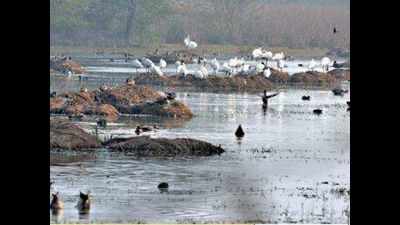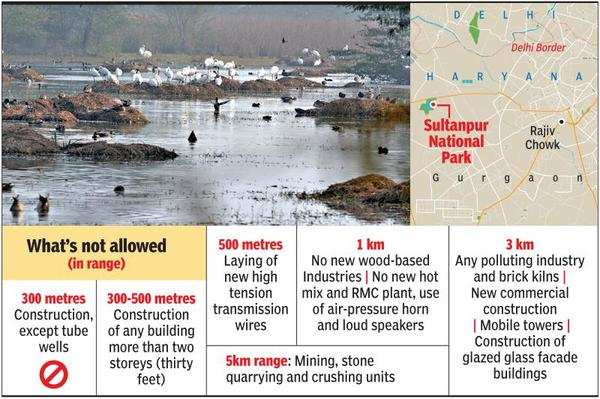- News
- City News
- gurgaon News
- Legal cover for Sultanpur as Haryana marks 5-layer eco zone
Trending
This story is from June 30, 2021
Legal cover for Sultanpur as Haryana marks 5-layer eco zone
One of NCR’s most popular bird sanctuaries now has legal protection around it. An area of up to 5km from the boundaries of Sultanpur National Park has been declared as an eco-sensitive zone by the Haryana forest and wildlife department. Fifteen revenue estates, comprising 22 villages, will now come under the eco-sensitive zone.

A zonal master plan for the area was notified on June 18. According to that, no construction will be allowed within a 300m radius of the sanctuary.
GURUGRAM: One of NCR’s most popular bird sanctuaries now has legal protection around it. An area of up to 5km from the boundaries of Sultanpur National Park has been declared as an eco-sensitive zone by the Haryana forest and wildlife department.
Fifteen revenue estates, comprising 22 villages, will now come under the eco-sensitive zone.

A zonal master plan for the area was notified on June 18. According to that, no construction will be allowed within a 300m radius of the sanctuary.Laying of new high-tension transmission lines up to a distance of 500m from the national park will also not be allowed.
On the eastern side, the boundary of the national park will be the Gurgaon-Pataudi railway line, which is also the limit of the urban zone for the notified Gurgaon-Manesar Urban Complex Development Plan-2031. To the south of the national park is the Kundli-Manesar-Palwal (KMP) Expressway.
Each area in the eco-sensitive zone will have different sets of regulations. No new wood-based industries can come up within 1 km of the national park’s boundaries. No polluting industry, as notified by the Central Pollution Control Board (CPCB), and brick kilns will be allowed within 3km.
Buildings having more than two storeys (maximum height 30 ft) cannot be constructed in the zone between 300m and 500m, which is a protected area. No new commercial construction will be allowed within 3km of the park. Mining, stone quarrying and crushing units cannot come up in the 5km radius. Single-use plastic is banned in the entire area. Discharge of untreated and solid waste is prohibited.
Officials said that no mobile towers can come up within 3km of the sanctuary and no new hot mix and RMC plants will be allowed. Use of air-pressure horns and loudspeakers is prohibited within 1km of the forest and burning paddy, wheat stubble and solid waste is banned. No glazed glass facade buildings can come up within 3km of the boundary of Sultanpur National Park.
Extraction of groundwater, however, is permitted but only for drinking and agricultural purposes.
The area will be monitored for water and noise pollution and felling of trees. Tourism-related activities, conditional repair and construction activities will be allowed. The activities that will be promoted in the eco-sensitive zone are agriculture and horticulture, rejuvenation of natural water resources, organic farming, vegetative fencing and agroforestry.
Fifteen revenue estates, comprising 22 villages, will now come under the eco-sensitive zone.

A zonal master plan for the area was notified on June 18. According to that, no construction will be allowed within a 300m radius of the sanctuary.Laying of new high-tension transmission lines up to a distance of 500m from the national park will also not be allowed.
The eco-sensitive zone has been divided into five categories. The first layer is the 300m buffer from the boundaries of the park. The second is up to 500m from the boundaries, the third up to a radius of 1km, the fourth up to 3km and the final layer till the 5km outer limit of the eco-sensitive zone.
On the eastern side, the boundary of the national park will be the Gurgaon-Pataudi railway line, which is also the limit of the urban zone for the notified Gurgaon-Manesar Urban Complex Development Plan-2031. To the south of the national park is the Kundli-Manesar-Palwal (KMP) Expressway.
Each area in the eco-sensitive zone will have different sets of regulations. No new wood-based industries can come up within 1 km of the national park’s boundaries. No polluting industry, as notified by the Central Pollution Control Board (CPCB), and brick kilns will be allowed within 3km.
Buildings having more than two storeys (maximum height 30 ft) cannot be constructed in the zone between 300m and 500m, which is a protected area. No new commercial construction will be allowed within 3km of the park. Mining, stone quarrying and crushing units cannot come up in the 5km radius. Single-use plastic is banned in the entire area. Discharge of untreated and solid waste is prohibited.
Officials said that no mobile towers can come up within 3km of the sanctuary and no new hot mix and RMC plants will be allowed. Use of air-pressure horns and loudspeakers is prohibited within 1km of the forest and burning paddy, wheat stubble and solid waste is banned. No glazed glass facade buildings can come up within 3km of the boundary of Sultanpur National Park.
Extraction of groundwater, however, is permitted but only for drinking and agricultural purposes.
The area will be monitored for water and noise pollution and felling of trees. Tourism-related activities, conditional repair and construction activities will be allowed. The activities that will be promoted in the eco-sensitive zone are agriculture and horticulture, rejuvenation of natural water resources, organic farming, vegetative fencing and agroforestry.
End of Article
FOLLOW US ON SOCIAL MEDIA










